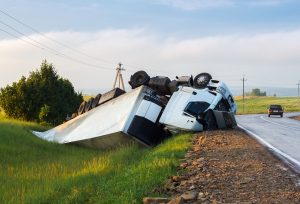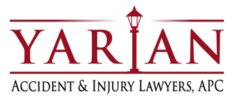Burbank Truck Accident Lawyer
According to the National Safety Council, more than 5,000 people die in trucking accidents and 160,000 individuals are left with significant injuries every year in the United States. Trucking accidents are not only a national concern but also a local concern, and Burbank sees its fair share of these devastating accidents.
Over the past several years, Burbank has been highlighted in the news as one of the most dangerous cities for motorists, with headlines constantly spotlighting trucking accidents that occur in and around the area. Take, for instance, the recent coverage of the large rig accident that shut down the Northbound 5 Freeway at the 134 after a truck lost control, jackknifed, and overturned, completely blocking all lanes.
If you have been a victim of a Burbank truck accident, you should not have to endure the aftermath of this terrifying incident and its devastating repercussions on your own. You deserve experienced legal help on your side, ready to take on your case and fight for the damages and justice you are entitled to. If you choose to work with Yarian Accident & Injury Lawyers, our Burbank truck accident lawyers can assist you with your legal claim and so much more.
About Yarian Accident & Injury Lawyers
Yarian Accident & Injury Lawyers was founded by attorney Levik Yarian to help injured clients get the best results possible for their clients in Burbank and the surrounding areas. Today the law firm continues to do just that while ensuring our clients get the attention they deserve, the quality representation they need, and the compassion they require during this challenging time in their life.
Because of our experience, dedication, and drive, we have helped thousands of victims and obtained millions of dollars on their behalf through settlements and jury verdicts, including a recent judgment of $8,250,000 for a truck accident claim.
We cannot promise these same results in every case we take on, but if you set up a free initial consultation with Yarian Accident & Injury Lawyers, we can assure you that our legal team will take a thorough look at your case and let you know what you can expect given the facts and circumstances of your situation. If we believe you have a strong case and you choose to allow us to represent you, our Burbank personal injury lawyers can promise we will fight hard to try to help you recover every last dollar your injury has cost you.

What Types of Trucks to Look Out For In Burbank CA
There are many types of commercial trucks on U.S. roadways. Each truck is designed for a different task. Some of the most common truck types, their cargo, and risks they pose include:
- Tractor Trailers – A tractor-trailer is also known as a “semi-trailer,” “18-wheeler,” or “big rig.” A tractor-trailer has large blind spots making them easy to hit merging vehicles. A tractor-trailer also has a high center of gravity, which makes a greater risk for the truck to roll over in an accident. A tractor-trailer can carry many different types of cargo based on its attached trailer. For instance, a refrigerated trailer will transport produce, while a dry van trailer may transfer Fed-Ex deliveries. The maximum weight of a tractor-trailer without a tandem is 20,000 pounds.
- Tanker Trucks – A tanker truck transports liquids or gases. Normally, tanker trucks carry classified hazardous materials. Tanker trucks are large with a high center of gravity and move very dangerous cargo. This makes any sort of accident incredibly unsafe as they are prone to rollovers and can blow up easily. An example of a tanker truck may be a Shell Jet, fueler tank truck, or irrigation water tanker truck. Tanker trucks have a maximum combined cargo and truck weight of 80,000 pounds.
- Dump Garbage Trucks – Any sort of garbage, trash, or work vehicle is considered a dump truck. A dump or garbage truck tends to be riskier for pedestrians or bicyclists. However, an accident with a motor vehicle can happen and is detrimental to a standard auto vehicle. Dump trucks carry waste, dirt, demolition debris, gravel, construction material, sand, and dry materials. Any accident with a garbage or dump truck can result in tip-overs and flying dangerous debris. Garbage and dump trucks usually weigh around 51,000 with cargo. An example of a company that uses dump trucks consistently is the waste management company you may see in your neighborhood.
- Tow Trucks –A tow truck is normally owned by a private operator or company. Tow trucks are large, weighing nearly 10,000 pounds, they make up the majority of truck accidents. Accidents with tow trucks also can be dangerous due to the cargo they are carrying. For instance, a tow truck may have another car attached to its trailer and in an accident, the vehicle may be unattached and impact your automobile. Tow trucks are considerably smaller than most trucks. A tow truck can typically tow up to around 13,000 pounds.
- Flatbed Trucks – Trucks with long open trailers that accommodate easily loadable cargo are flatbed trucks. Flatbed trucks do not have walls or sides where the cargo is placed. Normally, flatbed trucks hold items that do not fit in trailers such as cranes, building materials, or machinery. A flatbed truck accident is incredibly dangerous since it can carry more weight than an enclosed tractor-trailer. Additionally, the cargo can dislodge and create lasting damages. The military very regularly uses flatbed trucks to move their heavy machinery and equipment. Flatbed trucks weigh nearly 45,000 pounds.
What is the Difference Between a Truck and a Tractor Trailer
Trucks and tractor-trailers are two different vehicles. They can be hard to discern from each other, but both vehicles have different roles. California freeway users are exposed to both motor vehicles often in their travels.
A single-unit truck is designed to transport property. The cargo-carrying capability of the vehicle is integral to the body of the vehicle. Basically, this means that a single-unit truck does not carry its cargo in an attached trailer. A single-unit truck cannot be separated from its cargo.
Single-unit trucks are weighed regularly. If a single-unit truck is greater than 10,000 pounds it is recorded in the FMCSA SAFETYNET database. It is also grouped based upon the number of tires and axles present.
However, a truck tractor is a vehicle configuration consisting of a power unit designed to pull or draw a semi-trailer. A truck tractor has no cargo-carrying capability unless it has an attached semi-trailer. Semi-trailers are designed so that some part of the weight rests upon the power unit. Truck tractors can also be known as “semi-trucks.”
Any truck tractor towing another motor vehicle is considered a “truck tractor.” These types of vehicle configurations are recorded in SAFETYNET based upon the presence and number of attached semi-trailers.
Common Types of Truck Crashes in Burbank

Each truck accident is unique, but some truck crashes frequently occur in Burbank.
They include:
- Wide turn collisions: Typically, if a truck driver is approaching an intersection and wants to make a right-hand turn, they need to swing their truck out to the left to ensure they have enough space to make the turn. When they do this, they often end up swinging wide into the adjacent lane and other motorists sometimes end up trapped between the truck and the curb.
- Truck rollover crashes: If a truck driver loses control of their truck and the truck ends up tipping onto its side, this is referred to as a rollover accident and can be deadly for everyone involved.
- Jackknife crashes: These types of collisions occur when a truck driver suddenly slams on their breaks and the trailer behind them swings out to a ninety-degree angle. As a result, the truck often rolls over on its side, leading to a disastrous crash.
- Blind spot crashes: Crashes involving a truck’s blind spots are common since most trucks have large blind spots that can cause the truck driver to lose track of other vehicles around them. Typically, blind spots are located in the back of the truck, the front of the truck, and on each side of the truck.
- Front and back crashes: A head-on collision often occurs when a truck collides with another vehicle head-on, while a rear-end crash results from a truck driving into the back of another motor vehicle. Although there are differences between these two types of crashes, both can lead to severe trauma or death, especially if the other car involved is a small passenger vehicle.
- T-bone collisions: These collisions usually occur when a vehicle such as a truck runs a stop sign or a red light and collides into another vehicle perpendicularly, forming the letter T at the point of impact.
- Under-Ride – Occurs when one vehicle travels under a truck from behind;
- Unchecked Load – occurs when a driver fails to check the load on the truck at all required regular intervals);
- Blowout of tires – occurs if a tire bursts while the vehicle is in motion which makes it nearly impossible to control;
- Break failures – occurs when the brakes on a commercial motor vehicle stop working temporarily;
- Rollovers – occurs when the strong grips on the tires fail to prevent the vehicle from rolling over;
- Blind spots – occurs when another vehicle is in a location in which the driver of a large commercial vehicle can’t see while driving
Common Causes of Trucking Accidents in Burbank
Driver error causes about one-third of all truck collisions. Driver error can occur for many reasons, but some of the most common causes of these devastating trucking accidents in Burbank include:
Speeding Trucks
Truck drivers play a significant role in our nation’s economy, transporting goods and products all over the country. As a result, drivers are often under immense pressure to meet deadlines and some truckers go to extremes to meet these goals, such as driving at excessive speeds.
Unfortunately, if a trucker drives faster than is appropriate for the vehicle, this can lead to a catastrophic collision. The faster a truck is going at the time of a collision, the greater the truck’s force of impact.
Operating a Truck While Fatigued
There are numerous regulations in place regarding how many hours a truck driver can drive in one shift. However, when companies have deadlines to deliver their goods to distant destinations in a short time, they sometimes put pressure on their drivers to meet these goals. Sometimes drivers skip mandatory breaks or drive through the night to make sure they meet strict target dates.
If a truck driver forgoes rest and sleep, this can result in lost coordination and slower reaction time in hazardous situations that may come up as they are driving. It can also lead to drivers falling asleep behind the wheel.
Distracted Driving
Driving for hours on end across long distances, especially in rural areas, can be tedious. Truck drivers often have to do this for days on end, which can lead to boredom and distracted driving. Distracted driving refers to any activity that diverts the driver’s attention away from the primary task of driving to other activities such as texting, eating, or even playing with the radio while driving.
Truckers Lacking Experience
Truck drivers are often required to complete a certain amount of training before they can drive a commercial vehicle. However, requirements sometimes fall through the cracks, and drivers who should not be on the roads end up driving a massive truck before they are ready. This can mean bad news for fellow road users, as rookie truck drivers may not know how to deal with issues such as bad weather or hazardous road conditions, potentially leading to deadly mistakes.
Faulty Trucks
Truck companies are supposed to inspect their trucks to ensure they are in good working condition and ready to hit the road. Unfortunately, some trucking companies put repairs off because of the costs associated with truck maintenance or the amount of time it can take to complete regular inspections.
Dangerous Burbank Roads
Burbank is known for some dangerous roadways and intersections. For instance, Interstate 5 sees more than a million motorists every day and it is often the main route for trucks trying to get to and from Los Angeles. Because of its significant congestion, this interstate is known for its tragic accidents and deadly truck crashes.
In addition, there are certain intersections in Burbank that are considered more hazardous than others, often leading to gruesome collisions.
They include:
- Chevy Chase Dr. and Burbank Ave.
- San Fernando Rd. and Western Ave.
- Verdugo Rd. and Colorado St.
Driving While Intoxicated
If a truck driver is under the influence of certain prescription medications, drugs, or alcohol, this can significantly impair their ability to make safe decisions on the road. As a result, devastating collisions often occur when truckers get behind the wheel while intoxicated.
Federal Truck Driver Hours
A timed truck driver is given a limit of miles/hours they are supposed to drive before their workday is over. These federal truck regulations are regulated by The Federal Motor Carrier Safety Administration (FMCSA). FMCSA regulations help improve safety for the driver and other vehicles to deter driver fatigue.
Most truck drivers follow these same guidelines:
- 14-Hour Duty Limit – A trucker is not allowed to drive beyond the 14th hour after coming on duty following at least 10 consecutive hours spent off duty.
- 11-Hour Driving Limit – This rule indicates how long a truck driver can drive. A truck driver is not allowed to drive for more than 11 hours. In order to drive again, the trucker must be off duty for another 10 consecutive hours.
- 60/70 Hour Duty Limit – This rule is based on a seven or eight-day period. It varies on the driver and depends on the types of hours and days of the week he works. If a trucker has been on duty for 60/70 hours during seven or eight consecutive days they are not allowed to continue to drive. A trucker may restart the 60/70 hour rule after at least 34 consecutive hours spent off-duty.
The Statute of Limitations to Bring an Injury Claim Following a Burbank Truck Accident
The statute of limitations is a law that sets out the amount of time an individual has to file a claim after an alleged offense. If the injured person does not file a lawsuit within the allotted time, they are generally barred from collecting compensation for their injuries and losses.
In California, the statute of limitations for an injury claim following a Burbank trucking accident is two years from the accident date. Some limited exceptions to this rule can affect this filing period.
Following a Burbank truck crash, you should contact an experienced Burbank truck accident lawyer, such as Yarian Accident & Injury Lawyers as soon as possible. An attorney can promptly review your claim, determine the maximum amount of time you have to file your case, and ensure your legal documents are correctly prepared and filed before the time expires.
Liable Parties in a Burbank Trucking Accident
It may be surprising that, following a trucking accident, there can be numerous potential defendants who are legally liable for the accident, even if they were not present at the time of the crash.
These parties can include:
- The truck driver: If the trucker caused the accident because of their wrongful or negligent actions, they can be held accountable for the collision and the injuries that result.
- The trucking company: If a truck driver was an employee of a trucking company, there are situations in which the company can also be held responsible for the crash.
- Third parties: If other third parties caused or contributed to causing the truck accident, they too can be held liable for injuries and losses that resulted. These third parties can include other negligent drivers, a manufacturer whose defective truck parts contributed to the crash, and sometimes even government agencies if poor road conditions were involved.
Due to the number of defendants who can potentially be held responsible for a trucking accident, you should reach out to a knowledgeable Burbank truck accident lawyer at Yarian Accident & Injury Lawyers immediately following your crash. Through their independent investigation, an attorney can identify all the parties who bear responsibility for your accident and help you hold each one of them accountable for your injuries.
Common Injuries from Truck Accidents
A truck accident can be devastating. Due to commercial trucks’ large stature and weight, normally the injuries sustained are very severe.
Some common truck accident injuries include:
- Broken bones
- Head injuries such as traumatic brain injuries (TBI)
- Lacerations
- Fractures
- Rib and torso injuries
- Seat belt injuries
- Neck injuries
- Spinal cord injuries or paralysis
- Back and neck injuries
- Internal injuries
- Wrongful death
Filing A Wrongful Death Claim After A Truck Accident
California law only grants certain individuals the right to file a wrongful death suit. Just because you were a close friend of the deceased does not grant you the right to recover compensation from their death. According to section 377.60 of the California Code of Civil Action, the following parties can file a wrongful death suit:
- Spouse of the deceased
- The domestic partner of the deceased
- Children of the deceased
- Personal representative
There are certain situations where the deceased does not have a surviving spouse or children. When this is the case, a suit may be brought by anyone who is legally entitled to the deceased’s property through a will. This typically includes the victim’s parents and siblings.
If proven, certain financially dependent individuals may also have the right to file suit. These people include:
- A common-law spouse and children of the deceased
- Stepchildren of the deceased
- Parents of the deceased
Burbank Truck Accident FAQs
- First step is to call the police. It is very important you file an accident report, even if there is only minor damage.
- If you are physically able, take photos and videos of the accident scene including the vehicles involved. If other witnesses are around, write down their information and testimonies. All of these photos, videos, and testimonies can serve as evidence in your case.
- Seek immediate medical attention. Again, even if the injuries are only minor. Not only because your health and safety are important, but also because the medical reports can also serve as evidenced in your claim.
- Contact your insurance company and file a report. This step is incredibly important as if it can affect the outcome of your case. Speak as little as you can to your insurance company regarding the accident. State only the facts and do not elaborate.
- Finally, call (844)291-1911 for an experienced personal injury attorney with years of experience litigating truck accidents. You will need a trustworthy attorney who can advocate for your story and help you procure the settlement you deserve. Get in contact with a personal injury attorney at Yarian & Associates today.
- Commercial motor vehicles and drivers are subject to federal regulations regularly. Therefore there may be different statutes and regulations than a standard privately owned motor vehicle.
- The driver may not be the owner of the truck, and may be an employer independent contractor of a third party. If this happens there could be layers of liability involved in filing your claim.
- Some truck drivers are encouraged—or even required—to engage in unsafe practices to fulfill their employers or clients requirements making those third parties liable as well.
- If faulty equipment or vehicle maintenance played a role in the accident the manufacturers may be held liable.
- Tractor Trailer – Also known as a "semi-trailer," "big rigs," or "18-wheelers." Tractor trailers carry different types of cargo based on its attached trailer. For example a tractor trailer towing a refrigerated trailer can carry produce or other cooled cargo. A company that constantly uses tow trucks is Fed-Ex for deliveries.
- Dump & Garbage Trucks – Any sort of garbage, trash, or work vehicle is considered a dump truck. Dump trucks carry waste, demolition, debris, dirt, gravel, construction material, dry dangerous debris, and sand. Waste Management is a prominent company that uses dump and garbage trucks daily.
- Tanker Trucks – Tanker trucks carry liquid or gas cargo. Usually, tanker trucks carry classified hazardous materials. Shell gas company uses tanker trucks consistently to transport fuel across the United States.
- Tow Trucks – Tow trucks are normally used by a private operator or company. The cargo a tow truck carries is dependent on what is hooked or tied down on the truck. Some examples can be other motor vehicles, trailers, and construction equipment
- Flatbed Trucks – A truck with a long open trailer that accommodate easily loadable cargo. All flatbed trucks have no walls or sides where the cargo is placed. Cargo for flatbed trucks hold items that do not fit in trailers such as cranes, machinery, or building materials. The military consistently uses flatbed trucks to move heavy machinery or equipment.
- Tow Trucks – Accidents with tow trucks can be dangerous dependent on the cargo they are carrying. For example, a tow truck may have another car attached to its trailer. In the accident the vehicle may be unattached and add an extra impact on your automobile. Tow trucks can tow up to around 13,000 pounds and weigh around 8,000 pounds, so any sort of collision with a tow truck can be dangerous.
- Tanker Trucks – Most tanker trucks carry dangerous materials, making any sort of accident incredibly unsafe as they blow up easily. In addition to this, tanker trucks have a high center of gravity so they are prone to roll-overs. Tanker trucks have a maximum combined cargo and truck weight of 80,000 pounds.
- Dump & Garbage Trucks – Dump and garbage trucks are more risky towards pedestrians and bicyclists as they roam residential neighborhoods. An accident with a garbage or dump truck can result in tip-overs and flying dangerous debris. Garbage and dump trucks usually weigh around 51,000 with cargo.
- Tractor Trailers – Accidents with tractor trailers are dangerous because they have a high center of gravity, raising the risk for the truck to roll-over. The maximum weight of a tractor trailer without a tandem is 20,000 pounds.
- Flatbed Trucks – Accidents wit flatbed trucks are more dangerous than tow trucks because they carry more weight than an enclosed trailer. Additionally, the cargo can dislodge and create lasting damages in an incident. A flatbed truck without cargo normally weighs around 45,000 pounds.
- Head injuries
- Broken bones
- Neck injuries
- Internal injuries
- Spinal cord injuries or paralysis
- Back injuries
- Rib and torso injuries
- Lacerations and abrasions
- Seat belt injuries
- Amputations
- Paraplegia/Quadriplegia
- Wrongful death
- Animals
- Poor road design
- Shoulder drop-offs
- Pot holes
- Debris
- Loose gravel
- Limited visibility due to trees or other road designs
- Limited visibility due to insufficient lightning
- Poor road maintenance
- Poor intersection planning
- Narrow bridges and roads
- Missing or insufficient road reflectors or paint lines
- Missing or broken signage
- Nails, glass, or sharp objects
- 14 Hour Duty Limit – Truckers are not allowed to drive past the 14th hour after coming on duty following at least 10 consecutive hours spent off duty.
- 11 Hour Driving Limit – A truck driver is not allowed to drive more than 11 hours. In order to drive again, the trucker must be off duty for another 10 consecutive hours.
- 60/70 Hour Duty Limit – This rule is based on a seven or eight day period. It varies on the driver, and depends on the types of hours and days of the week he works. If a trucker has been on duty for 60/70 hours during seven or eight consecutive days they are not allowed to continue to drive. A trucker may restart the 60/70 hour rule after at least 34 consecutive hours spent off-duty.
- 30 Minute Break – A mandatory 30 minute break is necessary for drivers if they have driven consecutively for 8 hours.
- Past, present, and future medical costs
- Loss of wages and profits, projected and present
- Disability costs
- Property damage
- Emotional distress
- Pain and suffering
Get the Legal Help You Need Following a Burbank Truck Accident—Contact Yarian Accident & Injury Lawyers Today
To pursue a successful injury claim following a Burbank truck accident, you must present strong legal arguments and clear evidence proving fault and damages. Following your horrifying collision, this is probably the last thing on your mind.
Thankfully, with an experienced Burbank truck accident attorney on your side, you will not have to take on this complicated legal battle by yourself. A lawyer can provide you the legal help you need while you focus on what matters most—your recovery and healing.
Once you retain an attorney from Yarian Accident & Injury Lawyers, your lawyer can:
- Go over your truck accident case in detail, evaluate your legal claim, and determine which legal options you can pursue.
- Answer all the questions you have regarding your accident and the legal process involved with your injury claim.
- Investigate your truck accident and secure the evidence needed to prove what happened and who was at fault for your injuries.
- Bring in experts such as doctors, engineers, and accident reconstructionists to prove liability and substantiate your claim.
- Handle all the negotiations with the insurance company and the other side and pursue a just settlement.
- Proceed to trial, if needed, and fight for the maximum compensation you deserve.
If you or a family member has been harmed in a Burbank trucking accident, do not wait any longer to seek the legal help you need. Contact Yarian Accident & Injury Lawyers today for your free case evaluation and let our legal team show you what we can do for you and how we can pursue the justice that you deserve. You can reach us 24/7/365 at (818) 459-4999 and through our contact page. The sooner you contact us, the sooner we can help you.
Yarian Accident & Injury Lawyers Burbank Office
500 E Olive Ave Suite 720,
Burbank, CA 91501
(818) 459-4999
Additional Resources
Large Truck Fatalities – Visit the Insurance Institute for Highway Safety and read some information regarding large truck deaths in the U.S. See some recent 2016 statistics regarding commercial truck accidents, and how a driver may get into a crash.
Large Truck and Bus Crash Facts – Visit the Federal Motor Carrier Safety Administration’s website, a local government agency responsible for regulating safety of commercial motor vehicles. Read facts about large truck and bus crashes. See the recurring annual report that contains descriptive statistics about fatal, injury, and property-damage crashes involving large trucks and bus crashes.
Truck Accidents – Visit Consumer Safety’s website, a non-profit organization that strives to make information about recalls and safety-related news accessible to everyone. Read statistics, causes, tips, and solutions when a person has been in an accident with a truck.
Wrongful Death | California Code of Criminal Procedures – Follow the link provided to read the section of the civil code governing wrongful death. You can find a comprehensive list of individuals who are eligible to file a wrongful death claim and what is considered a domestic partner. You can also gain access to other statutes in the civil code.
Wrongful Death Jury Instructions – Jury instructions are guidelines for a jury when making judgments in a case. Follow the link to view a copy of the jury instructions used for wrongful death cases in California. You can find a list of questions the jury will ask themselves when deciding if a case falls within the scope of wrongful death.








